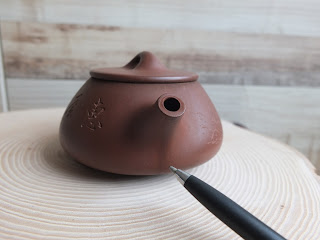Pink Dayi??
Take out your Dayi (aka Taetea) tea reference books…….there is purple dayi, silver, gold and even rose dayi, but no pink dayi.
This is what I was told by a Malaysian Dayi tea dealer and a few Dayi tea collector friends. This pink dayi was produced around 2002/03 and was a special order for a Taiwanese tea shop. This teashop had requested that this special order tea was to be sent 'naked' when the tea was produced and shipped to Taiwan. 'Naked' here means the tea cakes are shipped without the paper wrappers that you normally see on most pu erh tea cakes and bricks. I was told that the Taiwanese shop had produced their own wrappers and wanted to wrap the tea under their house brand wrappers. Conclusion - this is just a one-off special order tea for a tea shop.
I bought some pink Dayi. They were without wrappers. No, I did not buy this tea because of its nudity but rather I liked the tea after sampling this tea. Over the past weeks (after opening this cake), I noticed that when I wanted a raw pu erh session, I tend to reach out for this tea and when I have a session of this tea…. it was a 'quickie' session, in that I finished my 6-7 infusions quite quickly.
This tea brew strong. It has the characteristic Menghai Tea factory (Dayi) taste in the initial tea infusions. It is also slightly bitter. This tea aroma changes very nicely every 2 infusions, from hay and lumber wood aroma, to floral and herbal to sweet sugarcane aromas. And this tea gave me the 'sauna' session. Profuse sweating from the middle infusions. I hardly sweat when I drink Chinese tea and this was a rare event. Nice cool feeling after the tea session.
So….buy the tea you like. Pink dayi? Naked tea? I am loving it.












